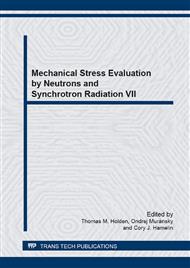p.188
p.194
p.199
p.205
p.213
p.219
p.225
p.231
p.237
A Neutron Diffraction Investigation of Residual Stresses in Rail Ends after Severe Deformation of Rail Surfaces
Abstract:
Insulated rail joints (IRJs) are a primary component of the rail track safety and signalling systems. Rails are supported by two fishplates which are fastened by bolts and nuts and, with the support of sleepers and track ballast, form an integrated assembly. IRJ failure can result from progressive defects, the propagation of which is influenced by residual stresses in the rail. Residual stresses change significantly during service due to the complex deformation and damage effects associated with wheel rolling, sliding and impact. IRJ failures can occur when metal flows over the insulated rail gap (typically 6-8 mm width), breaks the electrically isolated section of track and results in malfunction of the track signalling system. In this investigation, residual stress measurements were obtained from rail-ends which had undergone controlled amounts of surface plastic deformation using a full scale wheel-on-track simulation test rig. Results were compared with those obtained from similar investigations performed on rail ends associated with ex-service IRJs. Residual stresses were measured by neutron diffraction at the Australian Nuclear Science and Technology Organisation (ANSTO). Measurements with constant gauge volume 3x3x3 mm3 were carried in the central vertical plane on 5mm thick sliced rail samples cut by an electric discharge machine (EDM). Stress evolution at the rail ends was found to exhibit characteristics similar to those of the ex-service rails, with a compressive zone of 5mm deep that is counterbalanced by a tension zone beneath, extending to a depth of around 15mm. However, in contrast to the ex-service rails, the type of stress distribution in the test-rig deformed samples was apparently different due to the localization of load under the particular test conditions. In the latter, in contrast with clear stress evolution, there was no obvious evolution of d0. Since d0 reflects rather long-term accumulation of crystal lattice damage and microstructural changes due to service load, the loading history of the test rig samples has not reached the same level as the ex-service rails. It is concluded that the wheel-on-rail simulation rig provides the potential capability for testing the wheel-rail rolling contact conditions in rails, rail ends and insulated rail joints.
Info:
Periodical:
Pages:
213-218
Citation:
Online since:
February 2014
Authors:
Price:
Сopyright:
© 2014 Trans Tech Publications Ltd. All Rights Reserved
Share:
Citation:


